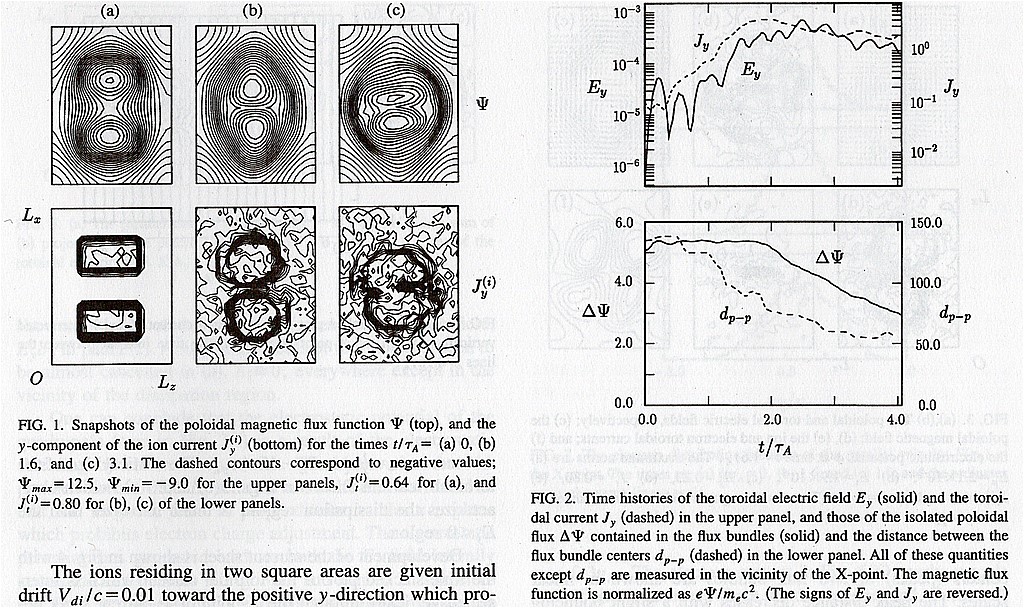....Why is the current sheet of the earth's distant magnetotail
to be thinned, and why is a large amount of energy to be released ?
This is typically observed as magnetic reconnection in magneto-
spheric space.
....However, this was haunted to Dr. Alfven as mysterious fluid-like
reconnection. Many theorists, there were many theories for this
reconnection, starting classical Dungey's theory to nuclear-fusion
oriented anomalous resistivity. Above them, Dr. Speicer paid
attention to the hypothesis of inertia resistivity to thinning the
current sheet, but his idea was highly criticized by public audience.
....Later in 1994-1996 by the macro-particle simulation - the low-
frequency simulation of ion and electron dynamics, it became clearly
proved that inertia of ions and electrons controls over input and
output of magnetospheric X-point flows of magnetic reconnection,
resulting in the large energy release of earth's magnetotail (Refs.1, 2-4).
It was also applied in the parallel shock of sun and earth environments
(Ref.5).
....The numerical simulation code of magnetic recennection is
downloaded here. -> https://github.com/Mtanaka77/ (Ref. 6)
M. Tanaka, Phys. Plasmas, 2, 2920-2930 (1995).

>> Macro-particle low-frequency simulation for magnetic reconnection
....An electromagnetic particle simulation code is utilized for solar and
magnetospheric space physics (Refs. 1,4-5). Both electric and magnetic
fields are solved at low frequencies by specifically a slightly backward
time decentering technique. The backward decentering does not affect
low frequency phenomena, \omega*Dt << 1 (Refs. 2,3). The separation
of electrons and outskirt ions at X-point as particles is shown in the
simulation.
....Magnetic reconnection and the solar wind-earth magnetic field
coupling are quite suitable for applying this simulation code. The code
is available by the author under GPL-3.0 License at
https://github.com/Mtanaka77/ (Ref. 6).
>> Article: Macro‐particle simulations of collisionless magnetic reconnection
M. Tanaka, Phys.Plasmas, 2, 2920-2930 (1995)
....The basic process of collisionless reconnection is studied in terms of
coalescence of two flux
bundles using an implicit particle simulation of two‐dimensions. As the toroidal electric field is
generated by magnetic induction, an elongated current sheet whose width
is a few electron skin
depths is formed. Sub‐Alfvénic plasma outflow off the reconnection region is generated in the
poloidal plane which spreads within the dual fans originating at the X‐point.
Significant toroidal
acceleration and streaming of the electrons without direct thermalization
is observed in the
current sheet. The electron parallel transport is proved to enhance the
reconnection rate by
comparing the implicit and hybrid‐particle simulations; in the latter the
electrons are spatially
frozen to the ions. The reconnection rate is insensitive to finite Larmor
radii of the ions in the
regime where the magnetic flux merges constantly in time. The simulation results support that
the collisionless reconnection is mediated by the electron inertia.
>> Article: Asymmetry and thermal effects due to parallel motion
of electrons
in collisionless magnetic reconnection
M. Tanaka, Phys.Plasmas, 3, 4010-4017 (1996).
Massachusetts Institute of Technology, Cambridge, Massachusetts 02139, USA
....Fast collisionless reconnection of magnetic flux loops by the macro‐particle simulation code
shows significant asymmetry of the plasma flow under an ambient toroidal
magnetic field. The
parallel motion of electrons induced by the reconnection electric field
is found to produce large
density and toroidal magnetic field inhomogeneities of a quadrupole shape,
δn/n0∼0.3, unlike
the m=1 mode. The divergence of the plasma flow is locally not identical to
zero with each
species, ∇⋅V(s)≠0 (s=e,i), due to the electron spatial movement along the magnetic field. This
internal structure results in a thick current layer and enhances the reconnection
process. A
plasmoid that impedes magnetic reconnection is created when the parallel
mass diffusivity of
electrons arising from their thermal motion is suppressed (the fluid limit).
The reconnection rate
becomes a smoothly increasing function of the ion mass and an inverse of
the toroidal magnetic
field, the latter of which being due to the compressional effect. The rate is drastically reduced
when the ion Larmor radius far exceeds the ion skin depth.
References
1. M. Tanaka, Macro-particle simulations of collisionless magnetic reconnection,
Phys.Plasmas, 2, 2920-2930 (1995).
2. M. Tanaka, A simulation of low-frequency electromagnetic phenomena in
kinetic plasmas of three dimensions, J.Comput. Phys., 107, 124-145 (1993).
3. M. Tanaka, Macro-EM particle simulation method and a study of collisionless
magnetic reconnection, Comput.Phys.Commun., 87, 117-138 (1995)
4. M. Tanaka, Asymmetry and thermal effects due to parallel motion of electrons
in collisionless magnetic reconnection, Phys.Plasmas, 3, 4010-4017 (1996).
5. H. Shimazu, M. Tanaka, and S. Machida, The behavior of heavy ions in
collisionless parallel shocks generated by the solar wind and planetary
plasma interactions, J.Geophys.Res., 101, 27565-27571 (1996).
6. M. Tanaka, Macro-Particle Simulation Code for Magnetic Reconnection,
at https://github.com/Mtanaka77/.
Japanese: Occurrence of collisionless magnetic reconnection
Go to the homepage